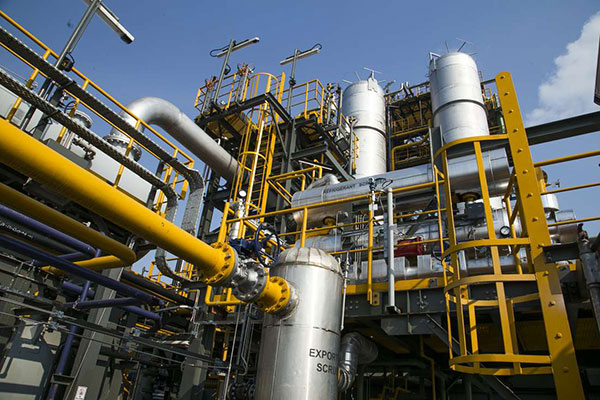Kenya is set to begin transporting the first batch of its Crude oil from the Lokichar oilfields — about 550km northwest of the capital Nairobi — to its storage facilities at the coastal city of Mombasa in readiness for export, moving closer to its dream of becoming a major oil producer.
Beginning this week, some 2,000 barrels of oil will be trucked from Lokichar to Changamwe daily, marking the beginning of the Early Oil Pilot Scheme (EOPS), which was supposed to kick off in June 2017, but was delayed mainly by disagreements over how revenues from the exports would be shared.
Kenya struck oil in the Lokichar Basin in 2012, with total recoverable reserves estimated at 750 million barrels.
President Uhuru Kenyatta is expected to flag off the first trucks on the 992km Lockichar-Kitale-Eldoret-Nairobi-Mombasa journey.
The Ministry of Petroleum said on Wednesday that it plans to accumulate about 400,000 barrels in Changamwe by December before it begins small-scale exports which are expected to pave the way for full field production by 2021.
“Once we have accumulated 400,000 barrels of oil, we will then begin a tendering process and sell to the bidder with the best price,” said Petroleum Principal Secretary Anthony Kamau.
Stockpiling barrels
Mr Macharia has said that the oil will be sold to international buyers through competitive bidding. Refining firms and international traders will be invited to bid once the cargo is stockpiled at Kenya Petroleum Refineries in Mombasa.
Mr Kamau said international tender for submission of bids is expected to be floated before the end of 2018 and crude will be sold to a bidder who offers Kenya the best price.
“Crude is expected to be discounted at $2 a barrel of prevailing price. The EOPS is not a commercial business venture but aims to establish a market before commercial crude production in 2022,” he said.
The EastAfrican, however, understands that it could take close to a year before the first batch of oil leaves the country for the international market, as it will take at least eight months to haul the 400,000 barrels to Changamwe.
Currently, Kenya has 80,000 barrels of crude stored in Lokichar awaiting transportation and is adding between 400 and 500 barrels per day.
The transportation will involve at least 110 specialised trucks with a capacity of 150 barrels each, making the 992km journey that could take over one week for a round trip.
According to the Petroleum Ministry, Kenya’s production capacity is expected to continue growing to about 2,000 barrels per day by 2019 and top 80,000 barrels once the construction of the 892km pipeline linking the Lokichar oilfields and the port of Lamu is completed.
Discussions on the construction and financing of the estimated $1.1 billion pipeline, which is being designed by London-listed Wood Group Plc, are ongoing, according to the ministry, ahead of the expected commercial production.
Revenue sharing
The ministry has defended the choice of road transport for the EOPS stage, allaying fears that the Kainuk Bridge on the Turkwel River on the Kapenguria-Kainuk road, which will be used to truck the oil, will not withstand the weight of the tanktainers.
“As far as we are concerned, the road is motorable, and renovation and upgrading works on the bridge will be completed by April next year. At the moment, we are not using the bridge but a ford we have constructed,” Mr Kamau said.
The drift can be risky during the rainy season due to high water levels, although the Kenya National Highways Authority is stabilising the riverbed with concrete.
Kenya was to export its first oil in 2017, but disputes emerged between the national government, the county government of Turkana and the local community over how proceeds from the commodity would be shared.
“We now have an understanding that can put Kenya in the league of oil exporting countries,” said President Kenyatta recently after reaching an agreement that raised the county government’s share of the oil revenue to 20 per cent and cut the national government’s to 75 per cent, while the local community retained 5 per cent.
However, as Kenya gears up to its first ever oil exports, it is still too early to celebrate.
“The issues of price, break-even point, and revenue sharing are not relevant at this point. This is no commercial venture,” Mr Kamau cautioned.
In 2016, Kenya’s Energy Ministry, which handled oil, said Kenya would make between $34 and $50 per barrel in profits from the export, which would place its break-even level above oil-rich economies such as Saudi Arabia at $23.50, but lower than Nigeria’s profit level of $31.60, according to data from Norway-based consultancy firm Rystad Energy.
The Kenyan government has also remained tightlipped on the revenue sharing agreements between itself and Tullow Oil, which says it has spent nearly $2 billion — recoverable from proceeds of oil sales — in exploration works in the Lokichar Basin since it started prospecting for oil back in 2010.
In Ghana, where Tullow has operations, it has made its petroleum agreements with the government and the relevant Deeds of Assignment public on its website.
At the time of export, the crude will be pumped from Changamwe to the Kipevu Oil Terminal jetty for loading into sea tankers. The terminal handles tankers with a capacity of 80,000 tonnes.



